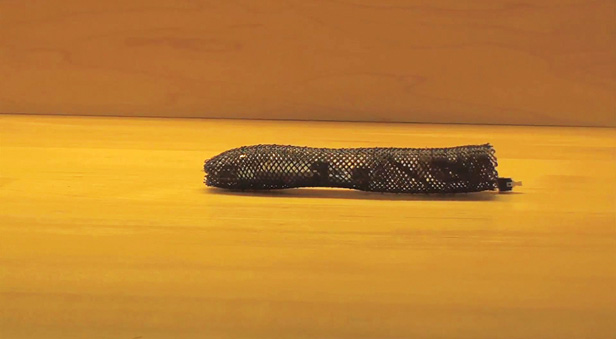
Earthworms creep over the ground by using a mechanism called peristalsis to squeeze and stretch muscles along their bodies, inching forward with each wave of contractions. Now researchers at MIT, Harvard University, and Seoul National University have engineered an autonomous robot that moves the same way. The robot, made almost entirely of soft materials, is remarkably resilient: when stepped upon or bludgeoned with a hammer, it can inch away unscathed. Researchers say such a soft robot may be useful for navigating rough terrain or squeezing through tight spaces.
To build the robot known as Meshworm, researchers created what they call “artificial muscle” from wire made of nickel and titanium—a shape-memory alloy that stretches and contracts with heat. They wound the wire around the mesh body to create segments along its length, much like the segments of an earthworm. Applying a small current to the wire heats it to squeeze the mesh tube and propel the robot forward.
The researchers, led by assistant professor of mechanical engineering Sangbae Kim, published details of the design in the journal IEEE/ASME Transactions on Mechatronics. They noted that earthworms have two main muscle groups: circular muscle fibers that wrap around the tubelike body and longitudinal muscle fibers that run along its length. The two muscle groups work together to inch the worm along.
To design a similar soft, peristalsis-driven system, the researchers first made a long, tubular body by rolling up and heat-sealing a sheet of polymer mesh. The mesh, made from interlacing polymer fibers, allows the tube to stretch and contract like a spring.
They fabricated a nickel-titanium wire and wound it around the mesh tube, mimicking the earthworm’s circular muscle fibers. Then they fitted a small battery and circuit board inside the tube and generated a current to heat the wire. Kim and his colleagues developed algorithms to control the wire’s heating and cooling, directing the worm to move in various directions.
The group subjected the robot to multiple blows with a hammer, even stepping on it to check its durability. Despite the violent impacts, the robot crawled away intact. “You can throw it and it won’t collapse,” Kim says. “Most mechanical parts are rigid and fragile at small scale, but the parts in Meshworms are all fibrous and flexible.”
Keep Reading
Most Popular
Large language models can do jaw-dropping things. But nobody knows exactly why.
And that's a problem. Figuring it out is one of the biggest scientific puzzles of our time and a crucial step towards controlling more powerful future models.
How scientists traced a mysterious covid case back to six toilets
When wastewater surveillance turns into a hunt for a single infected individual, the ethics get tricky.
The problem with plug-in hybrids? Their drivers.
Plug-in hybrids are often sold as a transition to EVs, but new data from Europe shows we’re still underestimating the emissions they produce.
Stay connected
Get the latest updates from
MIT Technology Review
Discover special offers, top stories, upcoming events, and more.